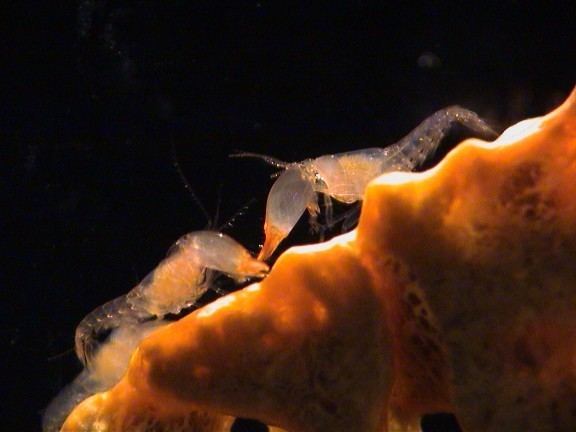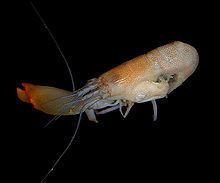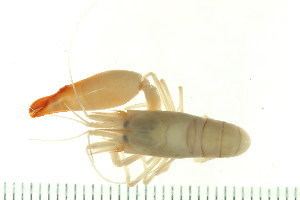Subphylum Crustacea Scientific name Synalpheus Rank Genus | Higher classification Snapping shrimp | |
 | ||
Similar Snapping shrimp, Crustacean, Decapoda, Synalpheus regalis, Caridean Shrimp | ||
Social and genetic determinants of eusocial behaviour in synalpheus snapping shrimps
Synalpheus is a genus of snapping shrimp of the family Alpheidae, presently containing more than 100 species; new ones are described on a regular basis, and the exact number even of described species is disputed.
Contents
- Social and genetic determinants of eusocial behaviour in synalpheus snapping shrimps
- Zuzalpheus
- Distribution
- Snapping
- Eusociality
- Species
- References

Zuzalpheus

The genus Zuzalpheus was established for S. gambarelloides, S. brooksi, and their closest relatives, which contain several notably eusocial species. While these do seem to form a clade, it is not fully resolved whether or not they are indeed the sister taxon of all the remaining Synalpheus.

However, a detailed cladistic study of morphological characters found well marked differences between the proposed two genera and concluded that the supposed species groups around S. biunguiculatus/S. coutierei, S. brevicarpus and S. neomeris are neither clearly defined nor, as it seems, monophyletic, while the group separated in Zuzalpheus was clearly distinct in characters of the minor first walking legs (pereiopods), and usually distinct in some others; in all Synalpheus sensu stricto checked to date, the transverse setal comb on the back of the minor first pereopod dactyl is missing, and the carpus is plump (about as wide as it is long or slightly wider) and small (not longer than half the length of the palm).

Moreover, their stylocerite clearly extends beyond the whole first segment of the first antennae, their scaphocerite blade is never missing, the fixed finger of the major first pereopod is about the same length as the dactyl and the uropodal exopod always has one tooth only; these traits however may be also present in some of the species separated in Zuzalpheus though as far as can be told, most of these differ. While the authors of the 2008 analysis made no explicit comment on the status of the newly proposed genus, they thus found the S. gambarelloides species group to be well-marked, and their results certainly harden the case for recognition of Zuzalpheus at least as a subgenus. However, this analysis only included 2 species from the S. gambarelloides species group, and none from the Caribbean, where the vast majority of the group resides. Opinion is still divided, however, and recently Zuzalpheus was synonymised with Synalpheus.
Distribution

In the narrower sense, Synalpheus occur in the East Pacific where they are most plentiful and probably originated, and to a lesser extent in the Atlantic and the Indian Ocean; the species placed in Zuzalpheus occur mainly in the western Atlantic where their lineage probably originated, and to a lesser extent in the eastern Atlantic and Indian Ocean, and the East Pacific. It may thus be that the closure of the Isthmus of Panama in the Piacenzian (about 3 million years ago) was a key factor in separating the two lineages, as species referred to Synalpheus sensu stricto are most plentiful in the western Pacific.
Snapping

The snapping behaviour of Synalpheus is rather well studied. In Synalpheus parneomeris, peak to peak source levels of 185–190 dB re 1 μPa at 1 m were measured, depending on the size of the claw.
Eusociality
The only known eusocial aquatic species occur within the genus Synalpheus. The species known to be eusocial are S. brooksi, S. chacei, S. elizabethae, S. filidigitus, S. rathbunae, S. regalis, S. microneptunus, and S. duffyi as well as potentially S. riosi. Eusociality has evolved at least three times within Synalpheus. It appears that there were multiple rapid radiations between 3 and 9 mya from which the ancestors of these eusocial species appeared. Eusociality is thought to have arisen due to competition for space, because among the species that host Synalpheus, empty sponges are rarely found. It also appears that kin selection was necessary for this evolution to occur because the only species in which eusociality has appeared are non-dispersing shrimp that hatch directly into crawling individuals. Until recently, eusocial species of Synalpheus have appeared in far greater abundance than and appear to outcompete less social species for space in sponges.
Species
Synalpheus contains the following species:
